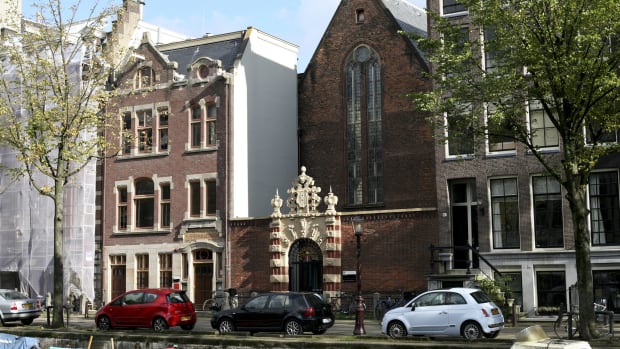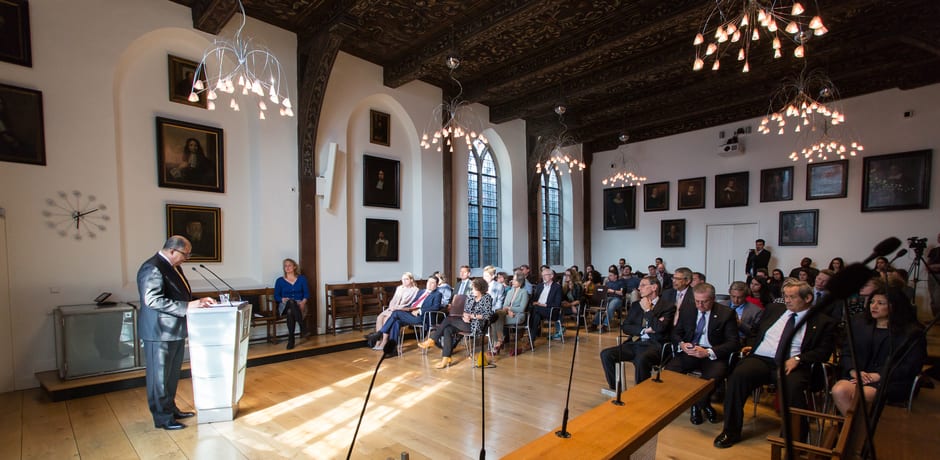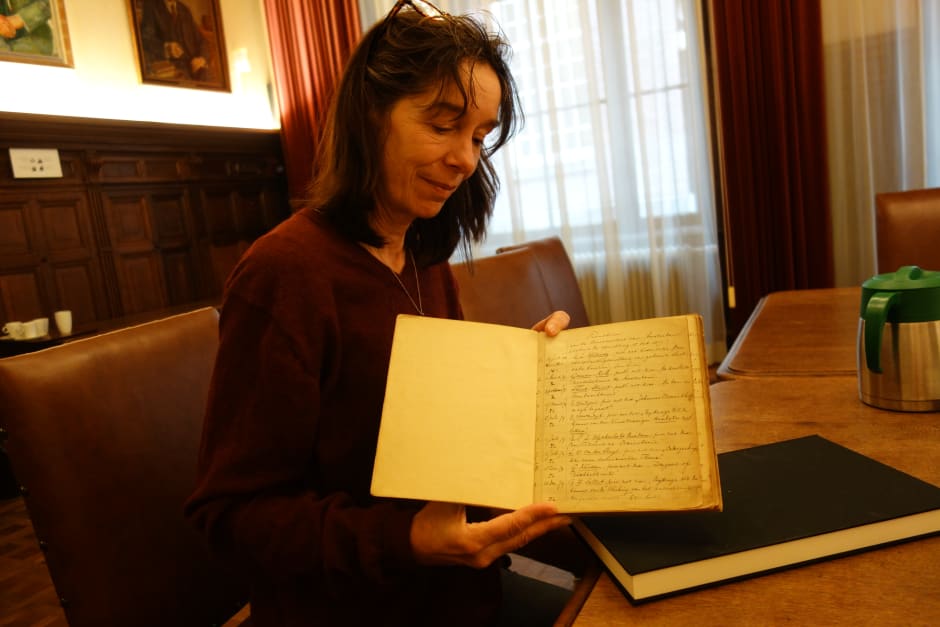
UvA-buildings | The Agnietenkapel: the birthplace of the UvA
The Agnietenkapel is actually the birthplace of the UvA: in 1632 the Athenaeum Illustre, as the predecessor of the UvA was then called, saw the light of day. Now the chapel is primarily used for PhD defences, degree ceremonies, and an occasional lecture. “Its a very special place for PhD students to receive their doctorate; it’s a very intimate place.”
As if ashamed and stepped back, sandwiched between two canal houses, stands the centuries-old building where the University of Amsterdam was born: the Agnietenkapel. On January 8th, 1632, the Athenaeum Illustre, the forerunner of the UvA, was inaugurated and the two famous humanist professors Gerardus Vossius and Caspar Barlaeus held their inaugural addresses there.
The ornate, gold letters inscribing “Athenaeum Illustre” in the ironwork above the gate cannot be missed. A small courtyard leads to a former monastery. Inside, Barlaeus and Vossius together adorn a large stained-glass window overlooking the nearby alley, now annexed to the property.
The Agnietenkapel was built in 1470 as part of a large convent for women. But because on May 26th, 1578, Amsterdam’s Catholic city council was forced to resign and the city joined the Protestant insurgents led by William of Orange, the convent became obsolete. After the chapel stood empty for some time, the Athenaeum Illustre moved in almost 50 years later.
The old sandstone gate that can still be seen today was second-hand, originating from an old city carpenter’s yard on the Doelenstraat. On the cast iron gate came a gold inscription with Athenaeum Illustre, and also, of course, the characteristic three crosses of the city of Amsterdam. The attic of the Agnietenkapel housed the City Library, the forerunner of the University Library. A fragment of the original ceiling paintings can also be admired there.

The books of the Athenaeum Illustre now form the basis of the Special Collections of the University of Amsterdam. This collection brings together rare and precious books, manuscripts, paintings, prints, drawings, photographs, archives, and scientific instruments. Some old bookcases in the attic under the painted roof of the chapel are reminders of this.
“It’s still a very special place,” says Annelies Dijkstra, who worked as a beadle, a ceremonial church official, in the chapel for many years. Now she is head of the department there, but as a beadle, she and her colleagues supervised hundreds of PhD ceremonies over the years. “UvA simply has wonderful places to celebrate academic ceremonies. As a beadle, I also visit the auditorium, which is larger and more imposing. But the Agnietenkapel is really a gem. I think it is very special for PhD students to receive their doctorate; it is a very intimate place.”

Symbolic
The building actually has three floors. There is the attic, as mentioned earlier; on the second floor is the auditorium where in the time of Barlaeus and Vossius lectures were given but now ceremonies are held in a kind of void; and the first floor has an area where receptions can be held. Dijkstra says: “At the end of the ceremony, the beadle, together with the young PhD candidate, walks out of the antique auditorium and into the void. The whole procession goes down a spiral staircase, which does not always feel safe with your gown, to the reception room. It’s almost symbolic. At the top, you are immersed in an ancient tradition, and coming down the spiral staircase, you descend back into the ordinary world.”
Between the first and second floors is still the so-called “sweat room,” where the doctoral candidate changes clothes and waits for the ceremony to begin. Hundreds of scrawled names on the walls and door - often already with Dr. in front of them - testify to the many people waiting there to calm their nerves.
The word Athenaeum was not chosen by accident. The institution was not allowed to call itself a university because Leiden objected to it, the city that held the monopoly for a university in the province of Holland. So it wasn’t possible to sit for an academic examination at the Athenaeum Illustre, but one could attend lectures every day from 9:00 to 11:00 a.m. They were public, but in Latin, so the question was how many people actually attended the lectures. There was supposedly an attempt to bring the scientist Galileo Galilei to Amsterdam, but he was very old at the time and considered Holland to be too far from Italy.
Sisters of St. Agnes
In 1998, the neighboring Purperhoedenveem or Purple Hat Guild building was purchased by the UvA and added to the chapel. This left the chapel's old walls exposed. “Veem was another word for guild,” Dijkstra explains. “The guilds were responsible for transporting goods to the warehouses. The guilds often named themselves after the color of their hats, indicating which guild the person belonged to. The hops workers no doubt had something to do with making beer.”
The chapel has been restored several times. The first small wooden building on the site of the Agnietenkapel burned down in 1395. The building was restored again in 1919 and one last time in 2007, when the Purple Hat Guild building was added to the chapel. During the 1919 restoration, workers came across coffins containing the remains of nuns: the Sisters of St. Agnes, from whom the chapel takes its name.


